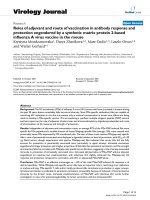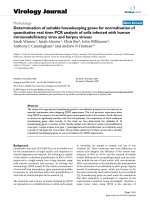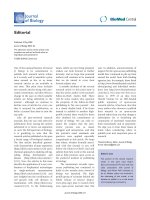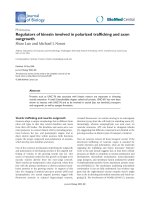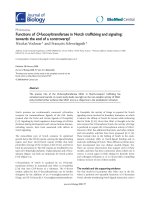Báo cáo sinh học: "Co-regulation of mouse genes predicts function" pps
Bạn đang xem bản rút gọn của tài liệu. Xem và tải ngay bản đầy đủ của tài liệu tại đây (91.85 KB, 5 trang )
Every eukaryotic genome-sequencing
project to date has revealed the pres-
ence of thousands of novel predicted
genes. Researchers interested in func-
tional genomics now face some formi-
dable challenges: defining how many
unknown genes are yet to be discov-
ered and working out what they do.
Now, in Journal of Biology [1], Timothy
Hughes and colleagues show that tech-
niques that were first applied to yeast
can be used to predict gene function in
mice (see ‘The bottom line’ box for a
summary of the work).
Hughes became something of a
microarray aficionado during his
postdoc at Rosetta Inpharmatics, LLC
in Seattle, USA. He and his colleagues
there demonstrated that a careful com-
bination of genome-wide microarray
analysis of gene expression patterns
and sophisticated statistical methods
could be used to predict gene function.
Specifically, they showed that patterns
of transcriptional co-regulation could
effectively predict the biological func-
tion of novel genes [2]. But those
impressive studies were performed in a
unicellular yeast, which has around
6,000 genes in total. It wasn’t clear how
well the approach would fare with
larger mammalian genomes and the
complexity of multicellular organisms.
When Hughes moved to the University
of Toronto, Canada, he was eager to
give it a try. Mark Gerstein of Yale Uni-
versity says that the Hughes study has
tackled an important problem in func-
tional genomics: “That is, translating
ideas that were found applicable in
simple unicellular organisms to more
complicated mammalian systems.”
A mountain of microarray
data
Hughes’ first concern was which genes
to spot onto his microarray slides (see
the ‘Background’ box). Researchers are
Research news
Co-regulation of mouse genes predicts function
Jonathan B Weitzman
BioMed Central
Journal
of Biology
Large-scale microarray analyses reveal that transcriptional co-regulation patterns can be
remarkably helpful in predicting the function of novel mouse genes.
Published: 6 December 2004
Journal of Biology 2004, 3:19
The electronic version of this article is the
complete one and can be found online at
/>© 2004 BioMed Central Ltd
Journal of Biology 2004, 3:19
The bottom line
• Genome-wide studies of gene expression in yeast, using microarrays,
showed that patterns of transcriptional co-regulation can predict the
biological function of novel genes.
• Microarrays have also been used to analyze the expression of 40,000
known or predicted mouse mRNAs across a range of 55 tissues.
• Sophisticated machine-learning algorithms (support vector machines)
can assign genes to transcriptional co-regulation groups, and these can
be matched to predicted functional categories, using Gene Ontology,
to predict gene function.
• The results challenge the conventional wisdom that tissue-specific
expression is indicative of gene function in mammals.
• The enormous gene-expression dataset generated during the study
will be an important open resource for future functional studies in
mice.
still undecided about how many genes
make up a mouse. “There is no ‘gold
standard’ cDNA database for mouse
genes,” explains Hughes. His team
chose to start with a single source, the
XM sequences from NCBI (see Table 1
for a list of the resources mentioned in
this article). “We downloaded the XM
collection from the NCBI. It’s almost
certainly not perfect, as it’s all done
using draft genome sequence, but it
seems to contain a large majority of
the known genes and a bunch of pre-
dicted genes, many of which were
detectable on the arrays,” says Hughes.
“The collection contains about 75% of
the current RefSeq sequences, it con-
tains the majority of Ensembl genes,
but it’s missing a lot of the RIKEN
clones.” The team then made a single
60-residue oligonucleotide for each of
the potential genes.
The Hughes team next got hold of
as many different sources of mouse
mRNA as they could and hybridized
them to the microarrays carrying over
40,000 spots. They found that 21,622
transcripts were expressed in at least
one of the 55 tissues examined. “We
didn’t really expect everything to be
expressed,” comments Hughes (see the
‘Behind the scenes’ box for more of the
rationale for the work). “We mostly
looked at adult tissues and we tried
not to look at stress responses.” He
notes, however, that the latest esti-
mates for the number of mouse genes
are somewhere around the 20,000 to
25,000 mark.
Mining the resulting data mountain
required a sophisticated bioinformatic
approach. “You have to know what you
are looking for and be able to formu-
late questions mathematically and
execute them on a computer,” notes
Hughes. Hughes teamed up with com-
putational colleagues in Brendan Frey’s
team and applied some fancy statistical
tricks, such as ‘variance stabilizing nor-
malization’, to allow comparison
across the tissues, and implemented a
learning algorithm called a support
vector machine (SVM) [3]. “If you
have a bunch of points in two- or three-
dimensional space, an SVM looks for
ways to distinguish between the ones
that have a given feature and the ones
that don’t. No one had used SVMs
before on this scale. If we have 55
tissues, then we are looking at 21,000
objects in a 55-dimensional space and
trying to separate the ones that have a
function from those that don’t.”
The statistical analysis revealed
that quantitative co-expression could
identify groups of genes with related
functions; the functions were deter-
mined as similar because annotation
designated the genes as belonging to
the same functional category within
the Gene Ontology (see Figure 1). In
19.2 Journal of Biology 2004, Volume 3, Article 19 Weitzman />Journal of Biology 2004, 3:19
Background
• High-density microarrays (often referred to as ‘DNA chips’) are
powerful tools for analyzing the expression profiles of all transcripts
under multiple conditions. Microarrays contain thousands of spots of
either cDNA fragments corresponding to each gene or short synthetic
oligonucleotide sequences. By hybridizing labeled mRNA or cDNA
from a sample to the microarray, transcripts from all expressed genes
can be assayed simultaneously; one microarray experiment can give as
much information as thousands of northern blots.
• The National Center for Biotechnology Information (NCBI) has
created many resources for genome annotation, the process of
identifying all genes and ascribing functions to the proteins that they
encode. The XM sequence database contains about 40,000 known
and predicted mRNA sequences generated automatically by an ab initio
gene-identification computer algorithm.
• NCBI’s RefSeq project provides a curated database of non-redundant
DNA, RNA and protein sequences for major model organisms. RefSeq
sequences are substantially based on sequence records from GenBank,
which in turn comprises original data from gene- and genome-
sequencing projects. An independent database is maintained by the
RIKEN Institute in Japan and contains the sequences of over 60,000
full-insert mouse cDNAs. A third source of annotated sequences is the
Wellcome Trust’s Ensembl project, which automatically annotates
metazoan genome sequences.
• A support vector machine (SVM) is a supervised learning algorithm
(or computer program). The algorithm addresses the general problem
of learning to discriminate between positive and negative members of
a given class of n-dimensional vectors. The SVM works by mapping a
given training set into a multi-dimensional space and attempting to
locate in that space a plane that distinguishes between different
groups.
• The Gene Ontology is a controlled vocabulary consisting of three
structured networks of defined terms that are used to describe the
attributes of gene products in terms of Molecular Function, Biological
Process and Cellular Component.
fact, the SVM method was so effective
that it could be used to predict func-
tions for hundreds of genes of
unknown function; indeed, the SVM
was a much better predictor of gene
function than were the simple tissue-
specific gene-expression patterns.
The Canadian group is not the first
to carry out such large-scale analyses of
mammalian gene expression [4-6].
“But what I like about this paper is that
it’s really rock solid,” says Stuart Kim
of the Stanford University Medical
Center, USA. “This is really believable
stuff. It is really well grounded in the
Journal of Biology 2004, Volume 3, Article 19 Weitzman 19.3
Journal of Biology 2004, 3:19
Table 1
The online genome-annotation and gene-listing resources described in this article
Resource URL Contents
NCBI XM sequences (from Non-redundant protein entries from a variety of
the non-redundant (NR) sources, including translations from annotated coding
database regions in GenBank and RefSeq
RefSeq A comprehensive, integrated, non-redundant set of
sequences, including genomic DNA, transcript (RNA),
and protein products, for major model organisms
Ensembl Annotated metazoan genomes
RIKEN FANTOM Functional annotation of mouse full-length cDNA clones
cDNA database
Gene Ontology Genes annotated according to three structured
networks of defined terms
Figure 1
Correspondence between gene expression patterns and GO annotations. Significance values resulting from applying a statistical test to each
correlation of a Gene Ontology functional category with expression in the indicated tissues shown with colors. See [1] for further details.
−log
10
(P), WMW test
55 tissues
ATP biosynthesis [GO:0006754]
Excretion [GO:0007588]
Carboxylic acid metabolism [GO:0019752]
Amino acid metabolism [GO:0006520]
Sulfur metabolism [GO:0006790]
Mitochondrion organization and biogenesis [GO:0007005]
Aromatic compound metabolism [GO:0006725]
Steroid metabolism [GO:0008202]
Fatty acid oxidation [GO:0019395]
Succinyl-CoA metabolism [GO:0006104]
Mitochondrial transport [GO:0006839]
Circulation [GO:0008015]
Oxidative phosphorylation [GO:0006119]
Glycolysis [GO:0006096]
Regulation of muscle contraction [GO:0006937]
Muscle contraction [GO:0006936]
Ectoderm development [GO:0007398]
Cell-cell adhesion [GO:0016337]
Vision [GO:0007601]
Neurogenesis [GO:0007399]
Locomotor behavior [GO:0007626]
Learning and/or memory [GO:0007611]
Behavior [GO:0007610]
Synaptic transmission [GO:0007268]
Endocytosis [GO:0006897]
Cholesterol biosynthesis [GO:0006695]
Neuropeptide signaling pathway [GO:0007218]
Mechanosensory behavior [GO:0007638]
Response to temperature [GO:0009266]
Brain development [GO:0007420]
Chromatin assembly/disassembly [GO:0006333]
RNA splicing [GO:0008380]
Cell cycle [GO:0007049]
DNA recombination [GO:0006310]
Pattern specification [GO:0007389]
Polyamine biosynthesis [GO:0006596]
Glycoprotein biosynthesis [GO:0009101]
Sexual reproduction [GO:0019953]
Spermatogenesis [GO:0007283]
Fertilization [GO:0009566]
Spermidine biosynthesis [GO:0008295]
Digestion [GO:0007586]
Smooth muscle contraction [GO:0006939]
Skeletal development [GO:0001501]
Bone remodeling [GO:0046849]
Oxygen transport [GO:0015671]
Antigen processing [GO:0030333]
Response to wounding [GO:0009611]
Innate immune response [GO:0045087]
Hemopoiesis [GO:0030097]
Lymph gland development [GO:0007515]
Kidney
Liver
Adrenal
Lung
Aorta
Heart
Skeletal Muscle
Skin
Digit
Snout
Tongue
Tongue surface
Trachea
Thyroid
Eye
Olfactory bulb
Whole brain
Striatum
Cortex
Cerebellum
Hindbrain
Spinal cord
Midbrain
Trigeminal nucleus
E10.5 Head
E14.5 Head
Embryo 12.5
Embryo 9.5
Embryo 15
ES
Placenta 9.5
Placenta 12.5
Uterus
Ovary
Testis
Epididymis
Prostate
Colon
Large intestine
Small intestine
Pancreas
Stomach
Salivary gland
Teeth
Mandible
Femur
Knee
Calvaria
Bone Marrow
Spleen
Lymph node
Bladder
Thymus
Brown fat
Mammary gland
420
statistics, avoiding simplistic non-
mathematical concepts like ‘on and
off’ or ‘two-fold up and two-fold
down’. They did fairly sophisticated
statistical analyses to make sure that
the trends they were seeing were really
valid. It’s important to get better and
better datasets published.” John
Hogenesch of Novartis Research Foun-
dation Genomics Institute in San
Diego, California, notes that
“[Hughes’] application of SVMs and
Gene Ontology to provide preliminary
functional annotation for thousands of
genes of unknown function is a major
advance.” The Hogenesch group is also
creating an atlas of mammalian genes
[5]. “This approach had been used in
yeast and worms, but it hadn’t yet
been applied to mammalian gene
expression. Hughes’ paper now pro-
vides testable hypotheses for the roles
of thousands of genes in the genome.”
An open resource at the click
of a mouse
Hughes’ analysis revealed that the
results from the extensive mouse
tissue-specific dataset correlates very
well with the results of studies from
other laboratories. One notable feature
of the Hughes dataset is that it has
been made openly accessible to the
research community [1,7]. The addi-
tional data with the published article,
and the Hughes lab website, provide
information about the microarray
oligonucleotide sequences, the SVM
predictions, gene annotation, and so
on, all of which can be downloaded
without restriction and free of charge.
Kim points out that this is really
important. “I think that every person
that works on mice should now go to
this study and type in the name of
their favorite gene(s) and see where it
is expressed in 55 tissues. It will cost
nothing and then you will know where
it is expressed strongly. You can make
sure there are no hidden surprises [in
your experiments] or find out what the
hidden surprises are.” Hogenesch
concurs: “Most users will use the
19.4 Journal of Biology 2004, Volume 3, Article 19 Weitzman />Journal of Biology 2004, 3:19
Behind the scenes
Journal of Biology asked Timothy Hughes about the background and
outlook for his ambitious project to map the functional landscape of the
mouse genome.
What motivated you to embark on the mouse microarray
project?
My group has mostly worked on yeast in the past. We had a lot of success
using microarrays to look at how gene expression can be used to predict
gene functions and to find transcriptional regulatory pathways. So, when
the mouse genome came out we thought that this was a reasonable thing
to try, assuming that if it worked in mouse it would probably work in
humans. There was the added bonus that we could use the microarrays to
validate the expression of predicted genes and contribute to the big goal
of finding all mammalian genes.
How long did the experiments take and what were the steps
that ensured success?
It took about two years: one to get the data and another year to do the
analysis. We did several things differently from other groups looking at
expression in different tissues: first, we think it was a good choice to use
NCBI’s XM gene collection. Then, we tested all the tissues from labs in
the Toronto area and I hired a medical student, Richard Chang, to dissect
mice over the summer to obtain the tissues we were still missing. Our
bioinformatics collaborators, Brendan Frey and his postdoc Quaid Morris,
were also indispensable; without them our paper would look an awful lot
like many other microarray papers.
What was your initial reaction to the results and how were they
received by others?
We were happy to see a good correspondence between gene expression
patterns and functional categories. It’s not trivial to figure out how all the
genes are regulated or how to use that data to figure out their functions,
but it’s worth doing. I think that it’s helpful to look at the co-regulation
patterns in an arbitrary sense rather than getting hung up on exactly what
tissue a pattern corresponds to. That’s the aspect that people are most
surprised about, and some members of the mammalian research
community are skeptical about whether it’s right. But we saw the same
thing in yeast, that genes are co-regulated in functional groups.
What are the next steps?
We are collaborating with local labs that do gene-trap mutagenesis and
make knockout mice. We plan to test several dozen of our functional
predictions, but these experiments literally take years. An important point
here is that showing that it works once or twice from a biological
standpoint is actually not as rigorous, from a statistics standpoint, as doing
the full cross-validation test which we did in the paper. Also, we will
probably work on computational approaches to find possible cis-
regulatory sites.
database to see where their gene of
interest is expressed and what pathway
it might participate in. Others will use
the dataset itself to ask questions using
other methodologies (tissue-specific
gene expression, regulatory-element
analysis, functional classification, and
so on). The types of things you can do
with a dataset like this are numerous,
which is why it’s important that the
data are available.”
Kim’s group is building large
genetic networks based on microarray
datasets [8]. “We use more than just
tissue specificity to build our networks
– we use everything that we can grab.
So, we will go and grab these data and
fold them into ours. Our next paper
will include 1,700 mouse microarrays
folded into the human-yeast-fly-worm
networks. In worms, many labs have
used our resource and published some
pretty awesome papers based on the
genetic network.” Kim thinks that the
networks will be even more powerful
in accelerating the pace of research in
mammalian systems, where classical
experimental approaches are slow and
expensive. Mark Gerstein agrees: “This
is an important advance in helping to
unravel the functions of the tens of
thousands of human genes using func-
tional genomics approaches.”
Hughes has enjoyed the transition
from studying yeast to working on
mice, and is eager to collaborate with
mouse geneticists to test some of the
predictions that come out of the
current study. And he wants to under-
stand more about the correlation
between co-regulation patterns and
gene function. “As a yeast researcher
the thing that blows my mind is how
many things animal cells do. I learned
a lot just looking at all the functional
categories and Gene Ontology,”
admits Hughes. “The correlation
between transcriptional co-regulation
and function is very strong. It’s much,
much higher than you would get if
genes were just expressed at random.
But it’s not absolute either. So, anno-
tating function is a hard problem to
crack and that gives us plenty to
work on.”
References
1. Zhang W, Morris QD, Chang R, Shai O,
Bakowski MA, Mitsakakis N, Mohammad
N, Robinson MD, Zirnglibl R, Somogyi E,
Laurin N, Eftekharpour E, Sat E, Grigull J,
Pan Q, Peng WT, Krogan N, Greenblatt
J, Fehlings M, van der Kooy D, Aubin J,
Bruneau BG, Rossant J, Blencowe BJ, Frey
BJ, Hughes TR: The functional land-
scape of mouse gene expression.
J Biol 2004, 3:21.
2. Wu LF, Hughes TR, Davierwala AP,
Robinson MD, Stoughton R, Altschuler SJ:
Large-scale prediction of Saccha-
romyces cerevisiae gene function
using overlapping transcriptional
clusters. Nat Genet 2002, 31:255-265.
3. Brown MP, Grundy WN, Lin D, Cristian-
ini N, Sugnet CW, Furey TS, Ares M Jr,
Haussler D: Knowledge-based analy-
sis of microarray gene expression
data by using support vector
machines. Proc Natl Acad Sci USA 2000,
97:262-267.
4. Bono H, Yagi K, Kasukawa T, Nikaido I,
Tominaga N, Miki R, Mizuno Y, Tomaru
Y, Goto H, Nitanda H, et al.: System-
atic expression profiling of the
mouse transcriptome using RIKEN
cDNA microarrays. Genome Res 2003,
13:1318-1323.
5. Su AI, Wiltshire T, Batalov S, Lapp H,
Ching KA, Block D, Zhang J, Soden R,
Hayakawa M, Kreiman G, et al.: A gene
atlas of the mouse and human
protein-encoding transcriptomes.
Proc Natl Acad Sci USA 2004, 101:6062-
6067.
6. Schadt EE, Edwards SW, GuhaThakurta
D, Holder D, Ying L, Svetnik V,
Leonardson A, Hart KW, Russell A, Li
G, et al.: A comprehensive tran-
script index of the human genome
generated using microarrays and
computational approaches. Genome
Biol 2004, 5:R73.
7. The functional landscape of mouse
gene expression
[ />8. Stuart JM, Segal E, Koller D, Kim SK:
A gene-coexpression network for
global discovery of conserved genetic
modules. Science 2003, 302:249-255.
Jonathan B Weitzman is a scientist and science
writer based in Paris, France.
E-mail:
Journal of Biology 2004, Volume 3, Article 19 Weitzman 19.5
Journal of Biology 2004, 3:19
